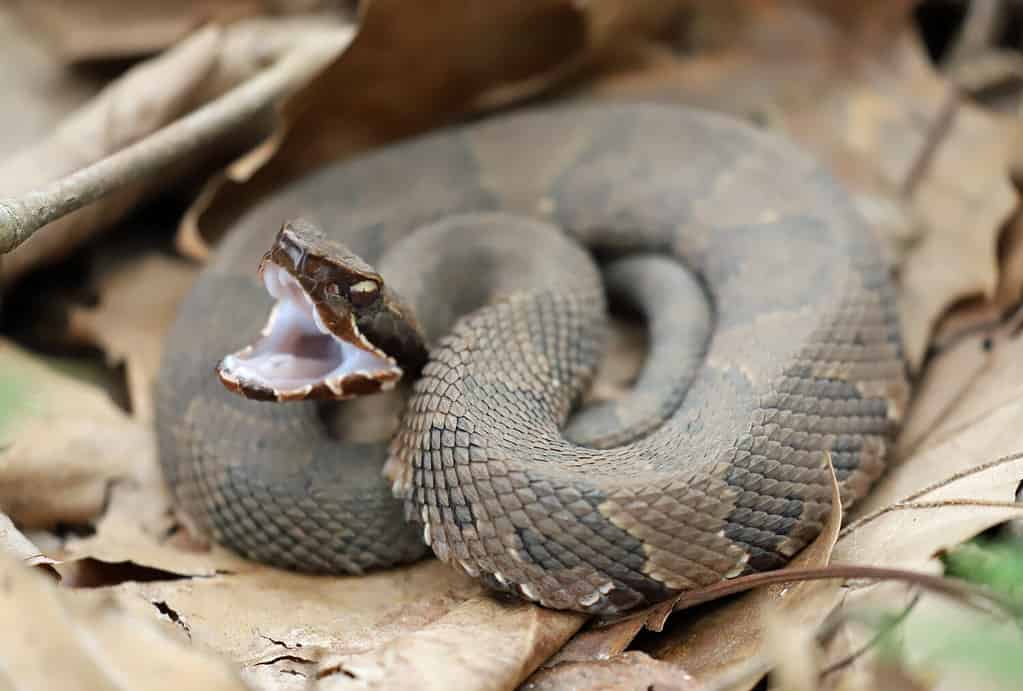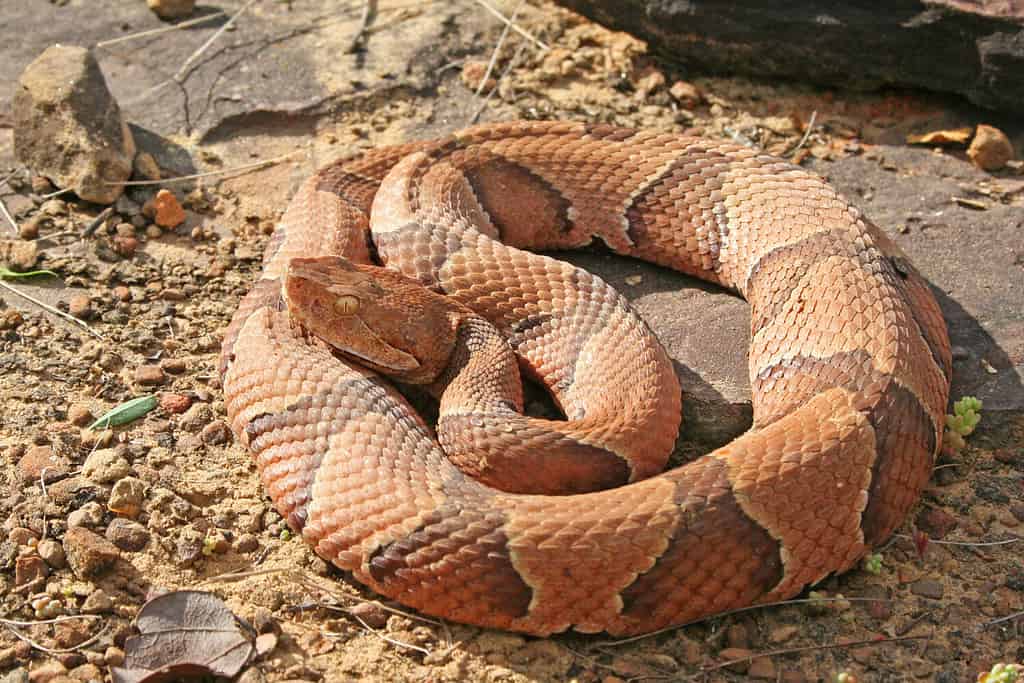Georgia is home to a vast array of animals, but snakes are particularly abundant. There are 46 species of snakes in the state, six of which are venomous. Georgia currently ranks in the third position for the number of venomous snake bites that occur every year, behind only Texas and North Carolina. So, let’s take a look at the most notable snake bite incidents in Georgia this year! We’ll also discover which are the venomous snakes in the state, and what to do if you see one.
Venomous Snakes in Georgia
Before we take a look at the scariest snake bites in Georgia, let’s discover the six venomous species and where they live.
Copperhead (Agkistrodon contortrix)
Copperheads are typically 24 to 36 inches long and are a distinctive reddish-brown color with darker crossband markings. They are widespread across the majority of Georgia, with the exception of the southeastern corner. Copperheads are particularly common in forests but may be seen across other habitats as well. They have fairly weak venom, although bites from them can still be serious.
Eastern Coral Snake (Micrurus fulvius)
Eastern coral snakes are approximately 18 to 30 inches long and have a distinctive appearance, typically with bands of black, red, and yellow. In Georgia, they mainly inhabit the coastal plain and the lower Piedmont area, where they are generally found in dry, open areas.
Cottonmouth (Agkistrodon piscivorus)

Cottonmouths are semi-aquatic and live in most freshwater habitats.
©KF2017/Shutterstock.com
The cottonmouth is the only venomous semi-aquatic snake in the state and is almost always found close to a permanent source of water — such as swamps, rivers, lakes, and streams. They are absent from the northeastern corner of the state but are particularly common across the coastal plain.
Cottonmouths are typically 24 to 48 inches long with dark brown bodies and dark brown to black crossbands. However, they can also be distinguished by their mouth which has a bright white lining, hence the name “cottonmouth.”
Eastern Diamondback Rattlesnake (Crotalus adamanteus)
The largest venomous snake in Georgia is the eastern diamondback rattlesnake which reaches more than six feet long. Eastern diamondbacks often have a tan or yellowish-brown background color which is overlaid with brown diamond-shaped markings. They live in the lower region of the coastal plain and inhabit forests, marshes, and grasslands. They have the longest fangs of any rattlesnake and have a very high venom yield.
Pygmy Rattlesnake (Sistrurus miliarius)
The smallest of Georgia’s venomous snakes is the pygmy rattlesnake which is only 14 to 22 inches long. Pygmy rattlesnakes typically have a light tan or greyish ground color with brown or black spots. They live in a variety of habitats across the majority of the state, with the exception of the far northern region. As the smallest species they don’t produce much venom, and bites are rarely fatal for healthy adults.
Timber Rattlesnake (Crotalus horridus)
Another large snake is the timber rattlesnake which reaches approximately five feet long. They are typically dark brown with black crossbands, although some individuals may appear to be almost entirely black. They are one of the most common venomous snakes in Georgia and inhabit most woodlands and forests.
Notable Snake Bite Incidents
Although Georgia ranks highly for the number of snake bites per year, not all of them make the news. However, there are a few that top the chart as being terrifying for all involved.
May 8, 2023

A copperhead snake bit an eight-year-old girl at Lamar Moody Lake.
©Creeping Things/Shutterstock.com
The first snake bite incident on our list involved an eight-year-old girl, Southerlyn Fisher, who was with her family at Lamar Moody Lake when she was bitten on the leg by a snake. Her leg quickly began to swell and her family rushed her to the hospital. The bite was believed to be caused by a copperhead and Fisher was treated with anti-venom. Thankfully, she made a full recovery after a short stay in hospital.
September 22, 2023
We can’t forget about our pets, and we’re sure that this incident was terrifying for the owner of this dog, especially as the outcome might have been entirely different if not for the actions of a USPS worker.
Holle Prigmore was delivering mail in Buchanan when she saw a copperhead snake bite a beagle on its back. After knocking on the front door and receiving no response she noticed a doorbell camera. Knowing that the beagle needed urgent treatment but being unable to contact the owner, Prigmore held a note up to the camera to inform them of what had happened. She then took the dog to the local veterinarian herself, where it was successfully treated and the owner contacted.
What to Do if You See a Venomous Snake

If you see a venomous snake then you should give it a wide berth.
©Mark_Kostich/Shutterstock.com
There are a few things that you can do to avoid being bitten by a snake. If you’re out and about then you should always step carefully over logs or go around them. You should also avoid putting your hands into any crevices or anywhere that a snake could be hiding.
If you do happen to see a venomous snake then the most important thing is to back away carefully and quietly. You should then give it a wide berth and leave it alone. Never attempt to move the snake or handle it. Snakes are not naturally aggressive, but they can be highly defensive if they feel as though they are threatened. There is a much lower chance of you getting bitten if you simply leave the snake alone.
What to Do if You Are Bitten by a Venomous Snake
If you are unfortunate enough to get bitten by a venomous snake or are with someone who has been bitten, then the most important thing to do is to seek medical attention immediately. You should never attempt to remove the venom yourself and you should not apply a tourniquet or ice. However, you should keep the wound below the level of your heart.
If it’s possible to do so from a safe distance, it’s a good idea to take a photograph of the snake. This will help doctors identify the snake and choose the appropriate anti-venom. Snake venom usually works fast, and the bite becomes more serious the longer you leave it. However, the sooner that anti-venom is administered, the greater the chance of recovery.
The photo featured at the top of this post is © Joe McDonald/Shutterstock.com
Discover the "Monster" Snake 5X Bigger than an Anaconda
Every day A-Z Animals sends out some of the most incredible facts in the world from our free newsletter. Want to discover the 10 most beautiful snakes in the world, a "snake island" where you're never more than 3 feet from danger, or a "monster" snake 5X larger than an anaconda? Then sign up right now and you'll start receiving our daily newsletter absolutely free.
Thank you for reading! Have some feedback for us? Contact the AZ Animals editorial team.






